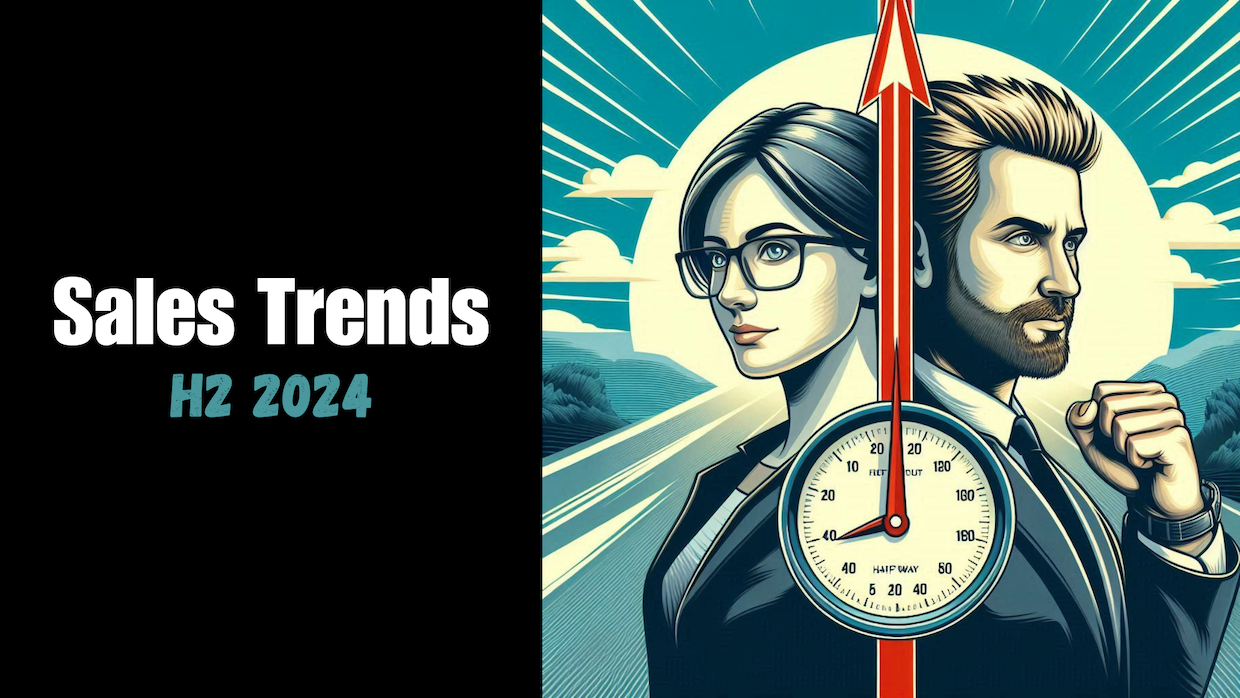Table of contents
As we kick off the second half of 2024, the sales landscape is, as always, a mixed bag of thrilling opportunities and nail-biting challenges. Whether you’re leading a scrappy startup squad or commanding a battalion in a well-established enterprise, understanding the latest market data and performance metrics is crucial. So, let’s dive into the latest numbers, analyze the trends, and see if we’re leading with strategic precision or simply managing by vibes.
The data for this article was pulled from research involving over thousands of sales professionals, companies, and executives. This isn’t just any data; it’s the freshest, straight-from-the-oven batch from Q2 2024.
The State of Sales Teams in H2 2024: An Overview
Sales teams have faced a whirlwind of changes over the past few years, with the pandemic-induced digital transformation pushing us into uncharted territories. Now, as we settle into H2 2024, it’s time to assess how these transformations are impacting sales performance.
The Good, the Bad, and the Ugly
Let’s start with the good news. According to recent data, the global sales market is projected to grow by 6.5% this year, reaching a whopping $29.7 trillion by the end of 2024. This growth is primarily driven by advancements in technology and increased consumer spending.
In H2 2024, the average sales cycle has lengthened by 8%, now standing at 106 days, compared to 98 days in H2 2023.
However, not all is rosy. Sales teams are grappling with heightened competition, longer sales cycles, and, let’s not forget, the ever-present threat of economic fluctuations. In H2 2024, the average sales cycle has lengthened by 8%, now standing at 106 days, compared to 98 days in H2 2023. This increase can be attributed to buyers being more cautious with their spending and taking longer to make decisions.
Performance Metrics: How Are We Really Doing?
Now, let’s break down the performance metrics. The latest market data reveals some interesting trends:
- Win Rates: The average win rate for sales teams in H2 2024 is hovering around 20.2%, a slight dip from 21.5% in H2 2023. While this might seem like a minor drop, it indicates a need for more effective sales strategies and better qualification processes.
- Quota Attainment: Only 58% of sales reps are meeting their quotas, compared to 63% in the same period last year. This decline is raising eyebrows and forcing sales leaders to reevaluate their target-setting and performance management practices.
- Pipeline Velocity: The average pipeline velocity (the rate at which deals move through the sales pipeline) has slowed down by 5%, emphasizing the need for more efficient sales processes and stronger alignment between sales and marketing teams.
Only 58% of sales reps are meeting their quotas, compared to 63% in the same period last year.
The Rise of Data-Driven Sales
In this era of data-driven decision-making, sales teams that leverage analytics and insights are outperforming their peers. Here’s how data is making a difference:
1. Predictive Analytics
Predictive analytics is no longer a buzzword; it’s a game-changer. By analyzing historical data, sales teams can forecast future trends, identify high-potential leads, and tailor their strategies accordingly. Companies using predictive analytics have seen a 20% increase in lead conversion rates and a 15% improvement in quota attainment.
Companies using predictive analytics have seen a 20% increase in lead conversion rates and a 15% improvement in quota attainment.
2. Sales Enablement Tools
Sales enablement tools are empowering reps with the resources they need to succeed. From AI-driven CRM systems to interactive content platforms, these tools are enhancing productivity and effectiveness. In H2 2024, sales teams using advanced enablement tools reported a 30% reduction in administrative tasks and a 25% increase in selling time.
3. Customer Data Platforms (CDPs)
Understanding customer behavior is key to closing deals. CDPs aggregate data from multiple sources, providing a 360-degree view of the customer. This holistic perspective allows sales reps to personalize their approach, resulting in a 10% increase in customer satisfaction and a 12% boost in upsell opportunities.
The turnover rate in sales is alarmingly high, with 35% of sales reps planning to switch jobs within the next year.
Challenges: The Roadblocks Ahead
Despite these advancements, sales teams face several challenges:
- Talent Retention: Talent retention remains a significant issue. With the rise of remote work and the gig economy, sales professionals have more opportunities than ever. The turnover rate in sales is alarmingly high, with 35% of sales reps planning to switch jobs within the next year.
- Economic Uncertainty: Economic uncertainty continues to loom large. Inflation, interest rate hikes, and geopolitical tensions are affecting buyer confidence. Sales teams must be agile and adaptable, ready to pivot their strategies in response to market changes.
- Technological Integration While technology is a boon, integrating multiple systems can be a headache. Sales teams often struggle with data silos and interoperability issues. Seamless integration and data consistency are critical for maximizing the benefits of technological investments.
Strategies for Success in H2 2024
To navigate these challenges and capitalize on opportunities, here are some strategies:
Embracing the Future
As we forge ahead in H2 2024, the key to success lies in embracing data-driven strategies, leveraging advanced technologies, and fostering a culture of continuous improvement. Whether you’re a sales leader or a frontline rep, staying ahead of the curve requires a blend of analytical prowess and human ingenuity.
So, are we managing by vibes or leading with data-driven precision? The choice is yours. But one thing is certain: in the ever-evolving world of sales, those who adapt, innovate, and stay informed will always come out on top.
Reading Progress












